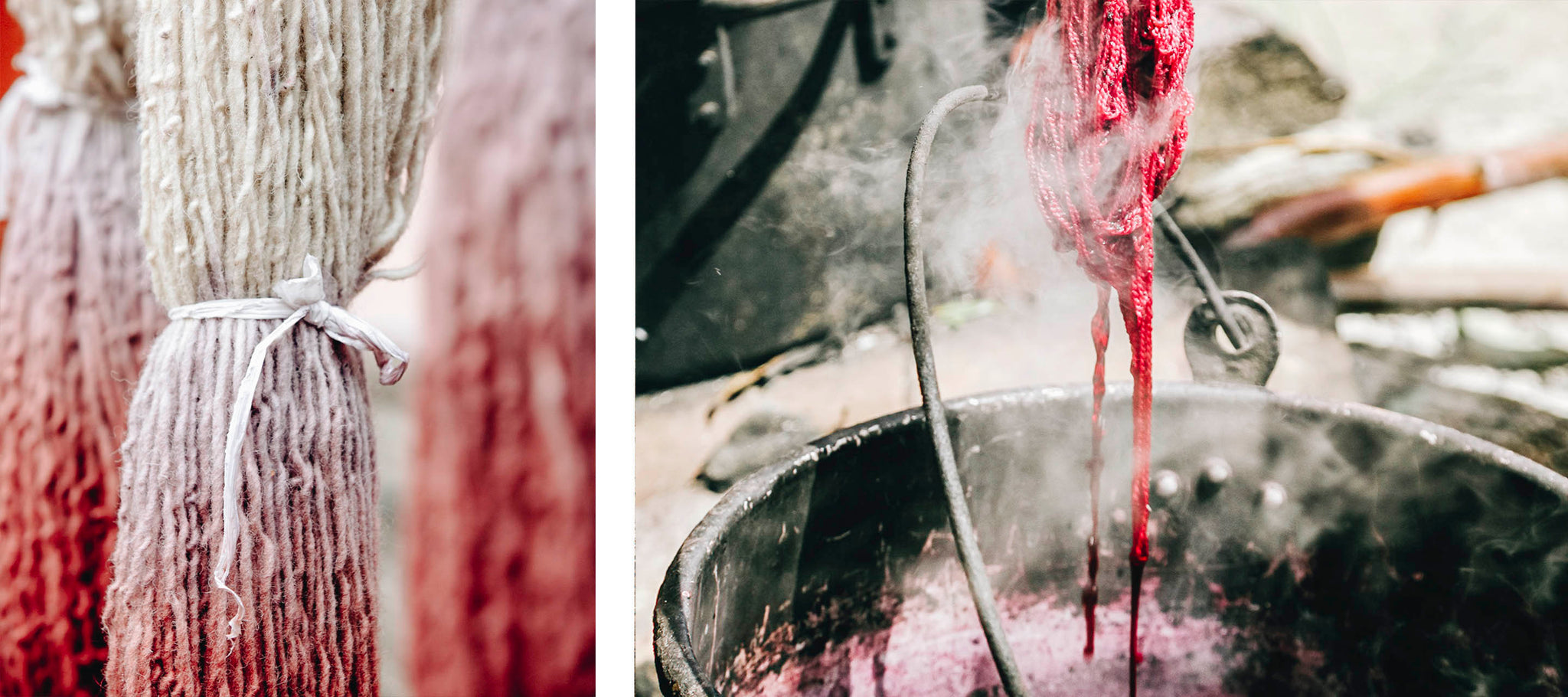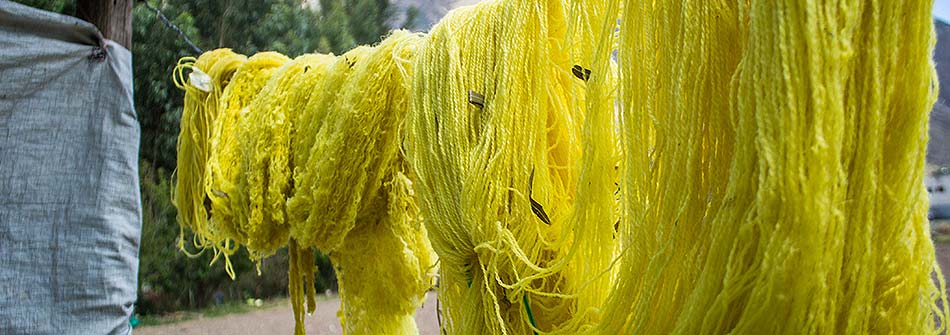
Our Quechua Collection uses natural dyes to color wool and alpaca fiber. The fiber is dyed by artisans using recipes that have been passed down through many generations.
Dyeing is part art, part science. Spun yarn is boiled for varying periods of time depending on the dyestuff used, the quantity of yarn to be dyed, and the desired color. Often fixatives such as mineral salts or urine are necessary to create color fastness, alter hues, or intensify color saturation. After the yarns have dried, they are re-spun, plied, and wound into balls of yarn, ready for weaving.
The Andes are filled with a great diversity of plant life and the Andean people have a rich knowledge of the use of these plants for medicines, and for natural dyes for their cloth.
 Techniques and materials required to achieve particular shades depend largely on the region and the materials available, as well as the education and experience of the dyer. At one time, most weavers would have been well-aware of the natural processes and materials for dyeing. However, the popularity of convenient synthetics nearly resulted in a complete erasure of these skills from indigenous culture, and a whole generation came to lack this knowledge. Thankfully, a recent resurgence of interest in the old ways – thanks in part to the demand for natural, handmade products – led to consultation with the elders who still remembered the processes, and the traditions have been rescued, at least in part. However, more education is required for the indigenous population to completely regain these traditions.
Techniques and materials required to achieve particular shades depend largely on the region and the materials available, as well as the education and experience of the dyer. At one time, most weavers would have been well-aware of the natural processes and materials for dyeing. However, the popularity of convenient synthetics nearly resulted in a complete erasure of these skills from indigenous culture, and a whole generation came to lack this knowledge. Thankfully, a recent resurgence of interest in the old ways – thanks in part to the demand for natural, handmade products – led to consultation with the elders who still remembered the processes, and the traditions have been rescued, at least in part. However, more education is required for the indigenous population to completely regain these traditions.

While it is generally accepted that natural dyes are better for human health and the environment than synthetic ones, we recognize that there is still a need for more complete and comprehensive research into the environmental impact of these natural dyes and processes. Threads of Peru hopes to organize, fund, and/or participate in such research in the near future.
The Natural Colors Of The Andes

- Red -
Red is a very important color to the Andean people. Since ancient times, red has been the brightest and most highly-saturated color that could be produced with natural dyes. This fact, coupled with people's innate love for bright color, has led to red playing a dominant role in the palette of traditional Andean cloth.
A wide range of red hues can be achieved with natural recipes.

Cochineal is the most commonly used substance for the production of red dye. It is a scale insect (a relative of the aphid) found on the prickly pear cactus, which is common to the Sacred Valley. The insect is dried in the sun and then ground into a fine powder using stones, a mortar and pestle, or a hand-turned grinder. This powder is then added to water and boiled as the basis of the dyeing process. Fixatives must be used with cochineal to adjust the pH and ensure color fastness. Depending on the type, quantity, and combination of fixatives used, cochineal can be used to dye a wide range of shades, from bright red to shades of pink, purple, and more.

Watch as the cochineal is crushed!
There are other substances that are used to produce red such as, Achancaray and Chapi plants (a relative of Old World madder), which were used in ancient Peru.
- Orange -

A common way to achieve the color orange is to add citric acid (known to local weavers as sal de limón, which literally translates as “lime salt”) to cochineal-dyed yarn.
Yanali, a slow-growing tree native to the high altitudes near the tropical Manu National Park, is also a common ingredient used for orange color. The bright orange bark is collected and chipped into small pieces before being added, fresh, to the dye bath. It produces a mustard yellow or yellowish orange yarn when boiled and fixed with salt.

The inner bark of the Chapi plant also produces shades of orange and coral. Chapi grows during August and September, and is found in the same region as Yanali.
Qaqa sunkha, which is a lichen, can also be used to produce orange. It is boiled with yarn, then about 1 cup of fermented urine (which has been stored for 2 weeks to 1 month prior to use) is added, as a fixative, and boiled for about 10 minutes.
- Green -

There are many ways to create the color green in Peru, depending on the region and the desired shade, using a variety of plants and minerals.
Ch'illca is perhaps the most common. It is a green leafy plant that has white flowers when in bloom. Big bunches of fresh ch’illca leaves are added to the dye pot, mixed with collpa, a mineral compound found in the jungle, and boiled for about an hour before yarn is added and boiled further.
Mutuy is another plant that can bue used to produce green following much the same process as with ch’illca; in Lares, Ñuñunqa is used.
This produces a very dark green which is often over-dyed with yellow, using plants such as Ñuñunqa, to produce a much lighter, brighter shade of green.
- Purple -

As with many colors, purple can be achieved in a variety of ways. A common method used in the Sacred Valley is the combination of cochineal and a fixative, such as copper or iron oxide.
Other methods include the use of a hard-to-find mountain plant, uncommon to the Sacred Valley, called Awaypili, and a seed called Mote Mote.
Awaypili can be purchased in the market. The dyeing process calls for the leaves to be boiled and the yarn to be added and turned every 5-10 minutes until the desired color is reached. When boiled and cooled, urine is added, which both fixes and intensifies the color.
- Blue -

A combination of Tara, which is a bean like pod, and blue collpa (which may be a local form of copper sulphate) is a common method of producing the colors blue and grey. The process calls for tara to be boiled with the yarn and the collpa to be added as a fixative. Color shades vary with time and measure of material.
When weavers can find it in the market, they will also use Indigo for the color blue. Known as añil in Spanish, indigo is a plant that yields a dark blue dye when processed. It does not grow in the Sacred Valley region, though the CTTC has recently been developing an indigo plant project in nearby Quillabamba.
- Yellow -

There are many plants and flowers which yield the color yellow. Q’olle flowers, from a small tree that grows in the region, are commonly used to make yellow, as well as some shades of orange. The yarn is boiled with the flowers and a variety of shades is achieved depending on the length of time the wool remains in the solution.

Q’aqa Sunka can be used to create shades of yellow, as can a combination of Mutuy and citric acid. Quico flowers, Ñuñunqa leaves and Molle leaves (a Peruvian pepper tree) are also known to produce yellow dyes.
- Neutrals -
Most neutral shades are found naturally as un-dyed fiber so there is no need to color the yarn to obtain hues such as grey, black and brown. However, sometimes these colors are unavailable and weavers need to dye the yarn. Un-dyed yarn may also be dyed to produce a more even natural color, given that natural fiber is often speckled with other shades (for instance, black may have specks of grey, brown and white blended in).
Grey
Discussed under the “Blue” section, tara mixed with blue collpa is a natural way of producing shades of grey. In addition, Eucalyptus leaves can be used to produce beautiful shades of silvery grey.
Brown
Qaqa sunkha can also be used to produce shades of brown by adding yarn to the left-over water after producing a batch of orange-dyed yarn. This weakened mixture produces a light brown.
Another important source of brown yarn is from nogal seeds and leaves. About two kilos of nogal is needed to dye one kilo of yarn, and it produces rich shades of very dark brown.
Black
Although natural dyes do exist that produce black, most people we have spoken to tend to laugh when we ask because sheep and alpaca all produce naturally black fleece!
